Almost 60 years after the death of Jimmy Bancks (July 1, 1952) and almost 90 years after he first drew Ginger Meggs, it is hard (for anyone who wasn't alive then) to realise just how significant Bancks and his creation were. Ginger Meggs, under the name of Us Fellers, was first published in 1921 in the Sunbeams pages of the Sunday Sun.
Novelist Ethel Turner edited sunbeams. She wanted to edit a children's paper, not a children's section in a Sunday newspaper. For 27 years she had edited a children's page in the Town and Country Journal but had been out of regular work since June 1919, when the paper went out of production.
In her book, The Diaries of Ethel Turner, Philippa Poole detailed how Turner had approached The Sun about starting a children's paper, Rising Sun, in July 1919 but nothing had happened. In September 1921 she agreed to edit the new children's section Sunbeams, but only on the understanding that the children's paper would follow. The four-page Sunbeams section was first published on October 9, 1921 and on November 13, 1921 a comic section was added without Turner’s consent. On the top half of the back page was Bancks' Us Fellers.

Ginger Meggs
Us Fellers alternated with a number of other comics for several months, and it wasn't until March 12, 1922, that it took up its position on the front page and became a weekly feature.
Turner was not happy for the comics to run in her section. She was also unhappy with their content, which she thought unsuitable for a children's section. She had decided to "resign or have the comics taken away". However she stayed, and so did the comics, and Us Fellers re-appeared in the November 27, 1921 edition of Sunbeams.
Ginger had been one of the boys in the first episode of Us Fellers. By the end of the year, Bancks had taken over the script writing from Grover and manoeuvred Ginger to be the centre of attention; it was not long before Gladys disappeared.
There were other changes too. Ginger had started out as Ginger Smith, but six months on he had become Ginger Meggs. By then he had a dog, Mike, and a younger brother, called Dudley. He also scored a best mate, Benny, a girlfriend, Minnie Peters, and a rival for her affections in Eddie Coogan. Within a year, just about the entire cast had been introduced, including Ginger's biggest problem, Tiger Kelly.
In September 1922, Hugh Denison, the owner of The Sun, launched the Sun News Pictorial in
Melbourne, sending Monty Grover to be editor. Bancks also went to
Melbourne to work on the new paper. He lived in
St Kilda and worked from a studio over Queen's Walk on the site of the Civic Square in Swanson Street. Us Fellers started appearing in the Saturday editions of the
Melbourne paper in October 1922.
In April 1923, Denison launched the Evening Sun in
Melbourne to take on The Herald, which was then being run by Keith Murdoch. By August, Bancks was drawing a new comic The Blimps, which ran three days a week in the evening paper. It was a busy time for Bancks, as he was also drawing political cartoons for the new paper as
well as Us Fellers. The Blimps was in reality a daily version of Ginger and it carried a credit line, "The Blimps - By Bancks, Creator of Ginger Meggs", just in case anyone didn't notice the similarity. Six months later The Blimps became Australia's first daily comic.

4 Ginger Meggs Sunbeams Books
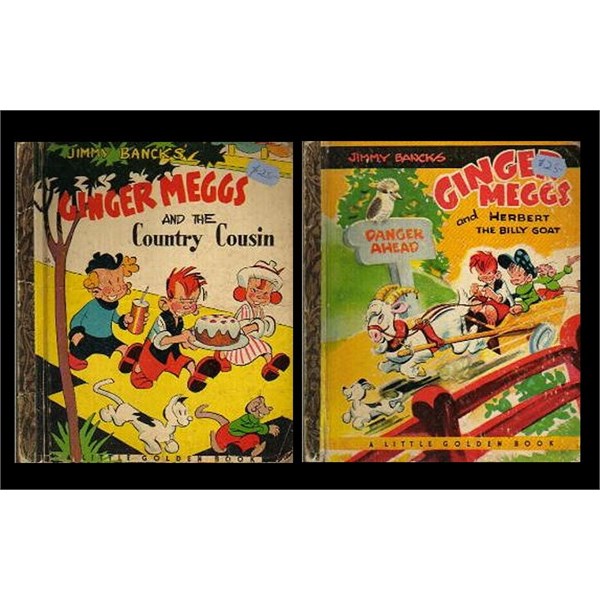
locally published Little Golden Books
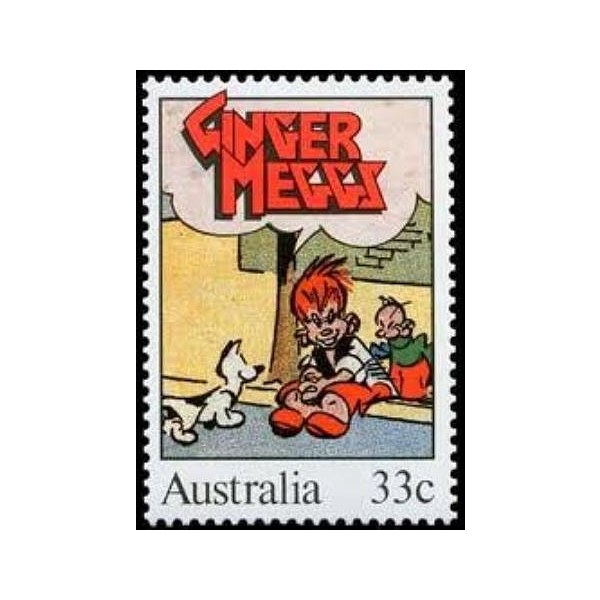
33c Stamp
Bancks put out the first of the Ginger Meggs Annuals in 1924, and they were to continue for the next 35 years. Ten years later it was estimated that almost two million copies of these annuals had been sold. There was also a Meggs film, Those Terrible Twins, for which Ginger acquired a sister and it was screened to packed houses in 1925.
In 1930, Bancks travelled to England to watch the Australian cricket team on its tour of England. He left behind enough Us Fellers strips to run each week while he was away. It was a momentous trip as the English were getting their first taste of Don Bradman who remembered Bancks as "a very kind and lovable man with a great sense of humour". Bancks included Bradman in a Ginger Meggs strip in 1932.
Ginger Meggs didn't live in any one place in Australia. He didn't move around either. The way Bancks drew the strip, it could have been set almost anywhere in the nation. But it had considerable similarities to the outer
Sydney suburb of Hornsby, where Bancks had lived from 1900 to 1909.
There were other influences too. The Little Boy from Manly had been around all of Bancks' life. As a Bulletin artist, he would have been conscious of Livingston Hopkins's image, created in April 1885, to symbolise Australia. In Hop's words, the Little Boy "...typified the
well-meant impetuosity of a
young Colony and eventually represented the State of New South Wales and Australia in many Bulletin cartoons".
Ginger Meggs got his red hair partly by accident and partly by intent. Because of the limited colour printing available when the comic started, Bancks could use only areas blue, red and yellow with his black line work. Ginger's hair could not have been blue and Bancks chose red to go with the name Ginger. Since then every red headed child in Australia has been called Ginger Meggs at least once in their life. Bancks also gave Ginge red shoes and red pants, it was a colour scheme he kept even when the strip went into full colour.
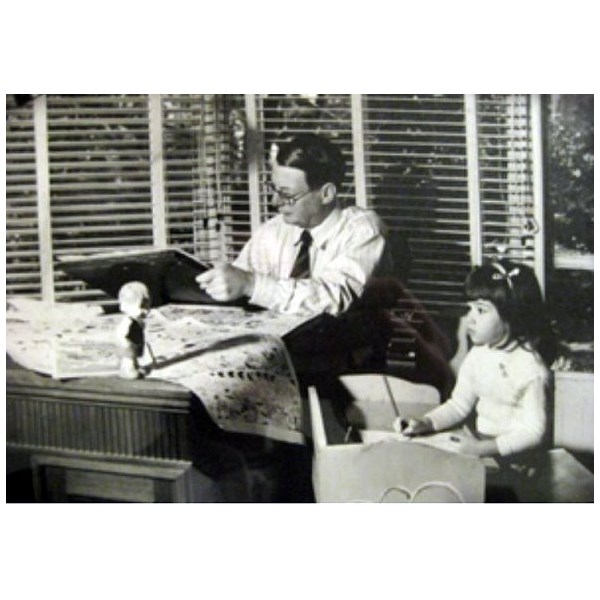
Bancks worked from home

Lloyd Piper

If only he wasn't around Record
Hornsby provided the perfect environment for Meggs. Fifteen
miles north from the centre of
Sydney, it had a rural flavour but also had a touch of the city. Of his time there, Bancks said, "It was not a noteworthy boyhood, but it was highly enjoyable, with the delights of swimming-holes, orchards, cricket and football. Remembering these pleasant happenings has resulted in hundreds of ideas".
In 1935 Eric Baume, then editor of the Sunday Sun, claimed Bancks had "created a post war character which was to sweep the Commonwealth and New Zealand. Ginger Meggs is the most human character created by any cartoonist in the second and third decades of the century. Not because Ginger is loved by the 280,000 readers of the Sunday Sun is this assertion made, but because the sheer Australian characteristics of the lad have endeared him to readers of newspapers in every part of this country and of New Zealand."
The then Prime Minister,
John Curtin, understood what was happening and said, "Ginger Meggs is Australia's Peter Pan. Most of us can recognise in him our own youth, but unlike him, we had to grow up". At the end of the war Dame Mary Gilmore suggested that "Australia is still
young and daring enough to be "Ginger" at the peace table - will Dr. Evatt please take note!"
Ginger Meggs moved to the Sunday Telegraph on June 3, 1951. He appeared, not on the front page, but as a double page centre-spread. Bancks, for the first time, drew himself into the strip reassuring the Meggs family, and the readers, that life would go on as before in the new paper.
As
well as Ginge moving, 80,000 readers moved from the Sunday Sun to the Sunday Telegraph. With that sort of following, Bancks could more than justify his high salary. The following week, Ginger Meggs was on the front page of the Sunday Telegraph comic’s section.
Ginger Meggs continued on the front page of the Sunday Telegraph's Comic Section and was still there when Packer sold both the Telegraphs to Murdoch in 1972.
With both Bancks and Nicholls dead there was one last move to be played in the battle between Fatty Finn and Ginger Meggs. Just over a year after Nicholls died, on August 27,1978, the Sun-Herald announced that Ginger Meggs was back - back to his original
home, as the Sun-Herald was, in part, a continuation of the Sunday Sun.
Ginger was also back in colour, filling
the spot Fatty Finn had left vacant. Fatty Finn was all but forgotten, except for two "echoes". In 1980,there was another Fatty Finn film, starring Bert Newton.
Sydney journalist and screenwriter Bob Ellis produced a book of the movie, The Adventures of Fatty Finn with illustrations taken from Nicholls' drawings.
Almost ninety years on, with Ginger Meggs having been drawn longer by other artists than it was by Bancks,
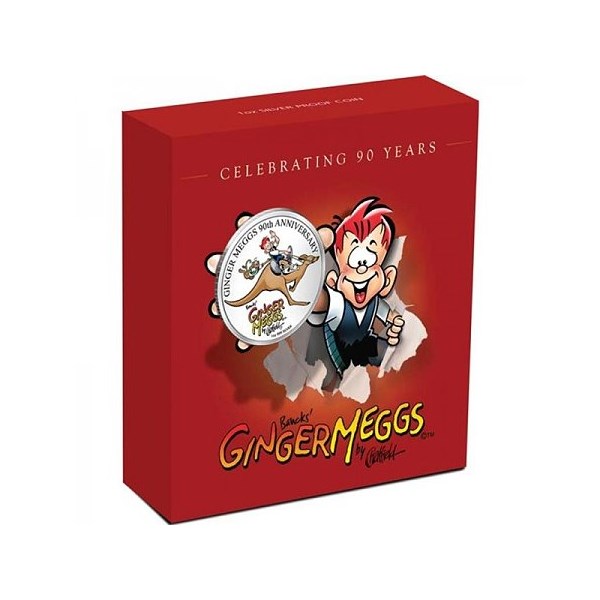
1oz Silver Proof Coin box

2011 Australian Ginger Meggs 90th Anniversary 1oz Silver Proof Coin set
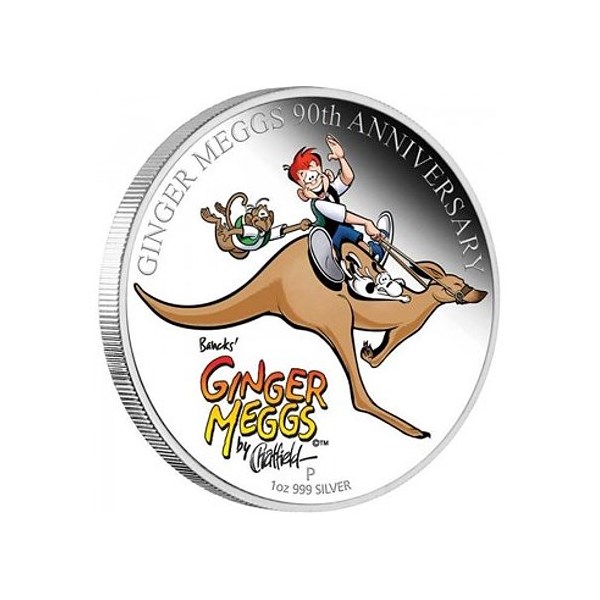
2011 Australian Ginger Meggs 90th Anniversary 1oz Silver Proof Coin
James C. Bancks created, wrote, drew and syndicated Ginger Meggs from 1921 until 1952, when he died unexpectedly of a heart attack. In the interim, there was a year's worth of strips to run while another artist was found.
Ron Vivian wrote and drew Ginger Meggs from 1953 until 1973.
Lloyd Piper wrote and drew Ginger Meggs from 1973 until 1983, when he died in a car accident.
James Kemsley wrote, drew and syndicated Ginger Meggs from 1984-2007. On 3 December 2007, Kemsley died at his
home in Welby, New South Wales. In the 2008 Queen's Birthday Honour lists, the Australian Government posthumously recognised Kemsley for his efforts with the Medal of the Order of Australia.
Jason Chatfield has written and drawn Ginger Meggs since 2007.
The strip remains the most widely syndicated Australian comic strip today, appearing in over 120 newspapers in 34 countries.
Ginger Meggs Park 24x Valley Road, Hornsby

Ginger Meggs Park
Ginger Meggs: The Movie - Part 1 of 10